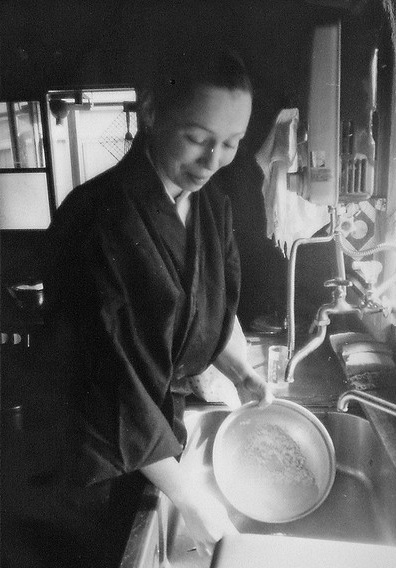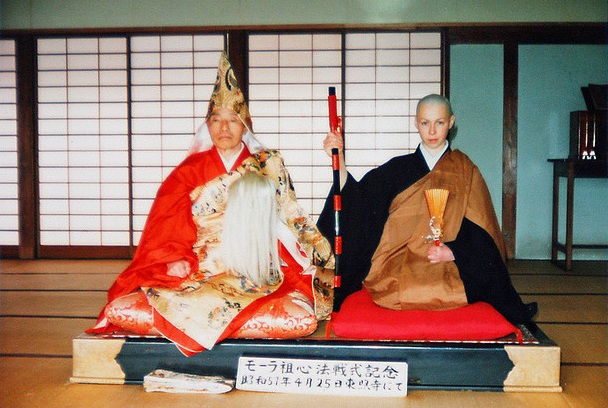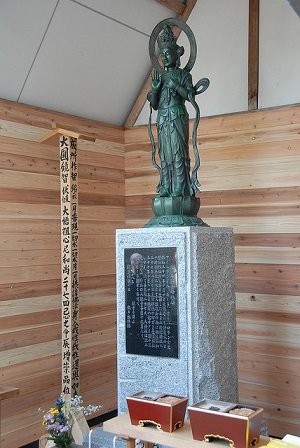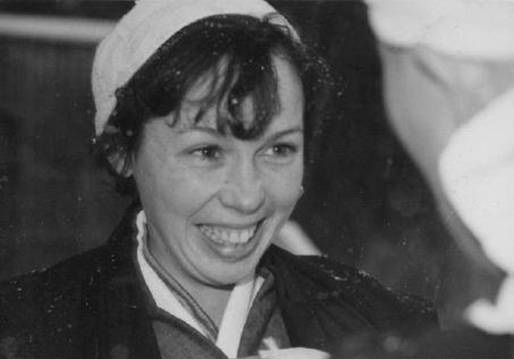
Maura O'Halloran (1955-1982)
祖心 Soshin (Pure Heart, Enlightened Mind)
Pure Heart, Enlightened Mind: The Zen Journal and Letters of Maura "Soshin" O'Halloran
Charles E. Tuttle Company, 1994
PDF: Pure Heart, Enlightened Mind: Riverhead Books, New York, 1994

伴鐵牛 Ban Tetsugyu (1910-1996) & 祖心 Soshin (Maura O'Halloran)
首座法戰式 Shuso hossen shiki (Dharma Combat Ceremony)

Mu (2013)
writer of bio-screenplay: Noah Buschel
The true story of Maura O'Halloran, who at the age of 24 left her waitress job in Boston to go to Japan. She was ordained as a Zen monk, her ordination name was Soshin (Pure Heart, Enlightened Mind), and after three-years of rigorous training at Toshoji Temple in Tokyo and Kannonji Temple in Iwate Prefecture, 1979-1982, O'Halloran received Dharma transmission from Tetsugyu Ban Roshi. Officially a Zen Master/Roshi, she decided she would teach in her homeland of Ireland. But first she would take a trip. Just months later, in Thailand, she was killed in a road accident on a bus. She was 27.

This Kannon statue is dedicated to Maura Soshin O'Halloran, an Irish/American woman who trained at Kannonji in the 80's. It reads:
"On the 10th of December 1979, at Toshoji temple she became a nun and began 1,000 days of continuous Zen practice at Toshoji and Kannonji Temples. Her daily practice included three hours of sleeping in the zazen position and twenty hours of devotion to her studies in order to attain salvation not only for herself but also for all beings.
On the 7th of August in 1982, she was conferred an authorized certificate of "Englightenment Achieved."
On the 22nd of October, on her way back to Ireland, at Chang Mai, Thailand, a traffic accident ended her life at the age of 27.
She is given the posthumous name of "Great Enlightened Lady, of the same heart and mind of the Great Teacher Buddha." Maura has been a real incarnation of Kannon Boddhisattva to be loved and respected forever.
We dedidate the Maura Kannon statue here to her extraordinary memory.
February 15, 1983 by Tetsugyu So-in, founder of Kannonji."

Maura O'Halloran (1955-1982)
Christian Zen Monk
by Robert Ellsberg
IN: All Saints: Daily Reflections on Saints, Prophets, and Witnesses From Our Time
http://www.gratefulness.org/giftpeople/ohalloran.htm
"Suddenly I understood that we must take care of things just because they exist."
In a Buddhist monastery in northern Japan there is a statue of a young Irish-American woman whose memory is revered by many pilgrims. How a Catholic woman came to be honored as a Buddhist saint is an interesting story of "interreligious dialogue." But it also says something about the convergent paths of holiness and their capacity to meet in a spirit of compassionate awareness.
Maura O'Halloran was born in Boston, the daughter of an Irish father and an American mother. When she was four the family moved to Ireland, where she was educated in convent schools and later graduated from Trinity College, Dublin. Her father died when she was fourteen, and she played a large role in the upbringing of her four younger siblings.
From a young age, Maura displayed a deep awareness of human suffering. After college she spent time working in soup kitchens and traveled widely in Latin America. Her concern for social justice was accompanied by a serious attraction to the spiritual life. After experimenting for some years with various methods of prayer and meditation, she decided to explore the wisdom of the East.
In 1979 she flew to Japan and applied for admission to a traditional Buddhist monastery in Tokyo. Many Catholics, and even Jesuit priests, have undergone training in Zen meditation in Japan, finding no inherent conflict between their Christian faith and the principles of Zen. But at the time of Maura's arrival there were few Western women who had been accepted into the very male world of a Zen monastery. Maura was admitted, and so she embarked on the rigorous training of a monk.
Her journals offer an unusual record of her experience, which included sustained periods of meditation, arduous manual labor, and an ascetic discipline of mind and body. Under the guidance of her Roshi (master), she struggled to solve her assigned koans, the famous Zen riddles designed to free the mind of dualistic illusions and lead the novice on the path to enlightenment. In the cold of winter she joined the other monks on an annual begging expedition in the North. With her shaved head and monk's robe, wearing only straw sandals in the snow and sleet, she would join the other monks as they passed through the streets, ringing a bell and holding out their bowls for alms and donations of food.
After six months of intensive training, Maura experienced an ecstatic breakthrough. While being interrogated by her Roshi she was suddenly overcome by tears and laughter. "It is enlightenment!" her Roshi cried. Afterward, when she went outside, she was overcome with a feeling of compassion for everything in existence.
This was not the end of her training. In the months that followed she concentrated more energy than ever on her meditation and her self-discipline. By the next year her Roshi made her an extraordinary offer. If she would agree to marry a fellow monk, he would entrust his temple to her. Torn between the desire to obey her Roshi and a conviction that this was not where she was intended to remain, she experienced a strange physical collapse. Her Roshi at this point accepted her plan to leave the monastery at the conclusion of her training. Some months later, Maura reflected on her vocation:
"I'm twenty-six and I feel as If I've lived my life. Strange sensation, almost as if I'm close to death. Any desires, ambitions, hopes I may have had have either been fulfilled or spontaneously dissipated. I'm totally content. Of course I want to get deeper, see clearer, but even if I could only have this paltry, shallow awakening, I'd be quite satisfied.... So in a sense I feel I've died. For myself there is nothing else to strive after, nothing more to make my life worthwhile or to justify it. At twenty-six, a living corpse and such a life! ... If I have another fifty or sixty years (who knows?) of time, I want to live it for other people. What else is there to do with it? ... So I must go deeper and deeper and work hard, no longer for me, but for everyone I can help."
As this reflection makes clear, Maura did not consider enlightenment something to be grasped for herself alone. Rather, she wished to empty herself to serve others in the way of compassion. This was Maura's wish. But it was not her karma. Instead, after leaving the monastery on her way back to Ireland, she was killed in a bus accident in Thailand on October 22, 1982. She was twenty-seven.
In a letter of condolence to her mother her Roshi wrote, "She had achieved what took the Shakuson [Shakyamuni Buddha] eighty years in twenty?seven years. She was able to graduate Dogen's thousand-day training. Then she left this life immediately to start the salvation of the masses in the next life! Has anyone known such a courageously hard working Buddha as Maura? I cannot possibly express my astonishment."
Through a memoir published by her mother in a Catholic journal and the later publication of her journals, Maura's story has earned a devoted following among Christians as well as Buddhists. Her short road to holiness in a Zen monastery has been compared to the compressed career of Therese of Lisieux, the French nun who set out as a child to become a saint. Both young women, having accomplished their spiritual business in this world, promptly departed. It is certain that Maura would have identified with the words of Therese, who said she hoped to spend her heaven doing good on earth.
http://bf.2zen.free.fr/2maura.htm
ZEN MESTEREK ZEN MASTERS
« vissza a Terebess Online nyitólapjára
No comments:
Post a Comment